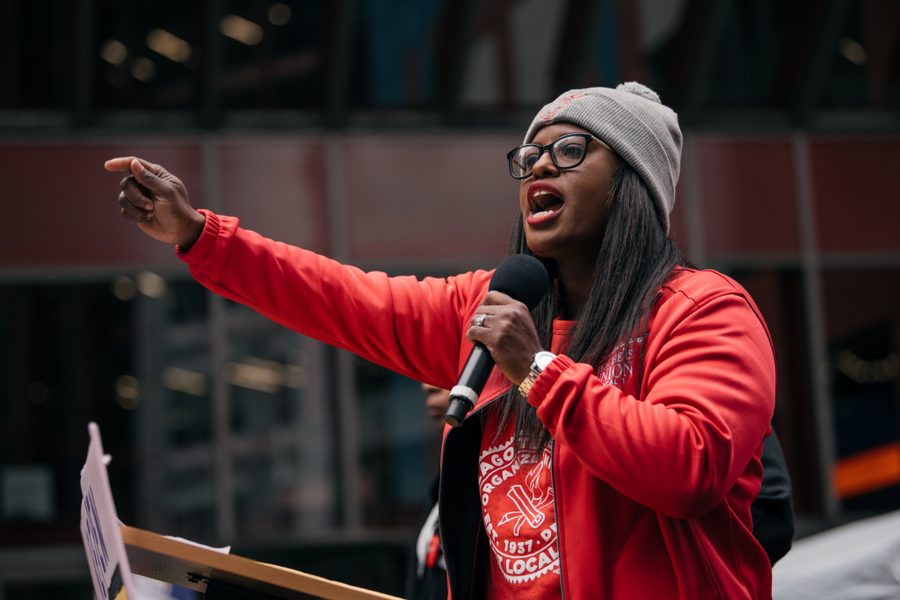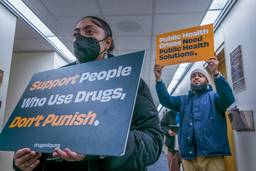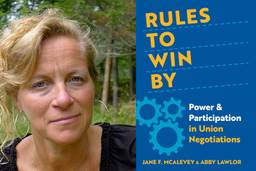Student Loans are a Burden for Black Educators. Cancel Them.
A conversation with Stacy Davis Gates, the vice president of the Chicago Teachers Union, about why canceling student debt is a labor issue.
Paige Oamek

On April 5, the White House announced it is extending the pandemic-era pause on federal student loan payments through August 31. (It had been set to expire on May 2.) The development followed escalating calls for debt cancellation from teachers, students and advocates, including an April 4 protest put on by the Debt Collective, the first union of debtors. The Biden administration’s decision to extend relief was welcomed by advocates but fell short of meeting the demand for permanent loan forgiveness. The Chicago Teachers Union (CTU), for example, passed a resolution in March calling on President Biden to use his executive power to cancel student debt and “increase spending in our local community.”
For teachers, the student debt crisis is personal. All states require teachers to hold at least a bachelor’s degree, while at the same time public school teachers earn about 20% percent less than similarly educated college graduates. Nearly half of all educators today took out student loans to pay for their college education. The average teacher carries about $58,700 in debt — roughly equivalent to a starting teacher’s salary at Chicago Public Schools. Black teachers across the country carry a disproportionately larger burden, as 1 in 5 still owes more than $100,000, according to the National Education Association. Nationally, Black women owe the most disproportionately high amount of student debt, compared to every other demographic group.
All signs suggest that, without meaningful and permanent intervention from the government, student debt is going to continue to pile up. According to a report from the Georgetown University Center on Education and the Workforce, the cost of college has increased by 169% over the past four decades — while young people’s earnings have increased by only 19%. Following Reagan-era cuts to financial aid programs, the price of college rose exponentially, with costs passed off to students. This trend was further cemented by even more state and federal funding cuts during the Great Recession, and spending has never returned to pre-2008 levels.
But unions are joining the fightback. CTU is the third largest teachers’ union in the country, with 25,000 members, and holds a reputation as a political powerhouse, known for taking on campaigns that blur the line between self interest and community interest. On April 4, CTU members were among hundreds of people, including fellow union members from the United Teachers Los Angeles and City University of New York’s Professional Staff Congress, who supported the Debt Collective Day of Action online and in person. The “Pick Up the Pen, Joe” rally took place in front of the U.S. Department of Education in Washington, D.C. There, the coalition of debt-holders presented a signature-ready Executive Order for Biden to sign to cancel all federal loans.
CTU has spent the last two years developing a relationship with the Debt Collective. Most recently, at the monthly CTU House of Delegates meeting on March 9, educators participated in a “coming out exercise,” sharing openly with each other the amount of debt they carry — to highlight how the issue affects union members.
When the CTU House of Delegates, the elected body of union representatives, ratified a resolution for student debt cancellation on March 9, it was the first time the union called for across-the-board student debt cancellation. CTU sees loan forgiveness as “only one step towards improving public education,” but states that “student loan debt is an often-overlooked barrier to diversifying the U.S. teaching workforce.”
In These Times spoke with Stacy Davis Gates, the vice president of CTU, about the impact of the student debt crisis on the union members, and its effect on Chicago’s remaining Black teachers.
Paige Oamek: What is your response to Biden’s latest announcement that he is extending relief on federal student loan payments until August 31?
Stacy Davis Gates: We’re grateful the moratorium on student loan payments has been extended. Now we need to keep up the people power to encourage Washington to provide permanent relief from these predatory, profiteering student loans. That must include breaking down the financial barriers that continue to hurt students — particularly Black and Brown students, including women — and making higher education accessible for all.
Paige: How is canceling student debt a labor issue?
Stacy: It’s a labor issue. And I would also say, it’s a racial justice issue. When we look at who’s carrying the lion’s share, that is Black women. I carry an extraordinary amount of debt from both college and graduate school. That makes it difficult for me to both work in public education and in labor. So it’s not easy balancing this whole load of student debt, as a first-generation college graduate, and also a mother of three.
I come from a generation of Black people, Black women in particular, who believed that getting a college education would afford us some upward mobility and create an infrastructure financially better than our parents. And what it has become is an albatross of sorts — this extra burden. I have a 13 year old, and I’m pretty certain that when he goes to college, I’ll still be paying off college and graduate school debt.
Paige: How does the issue of student debt impact teachers, specifically?
Stacy: I don’t even think it’s about teachers. I think it’s about the people who are not teachers because they can’t afford to be teachers. Many of our colleagues who went in another professional space did so so they could absorb their debt, instead of becoming educators.
People who have the level of education that I have typically don’t choose public education, because it doesn’t take care of the student debt, pay the bills or provide the infrastructure they need to become homeowners and take care of their families.
It limits the number of individuals who see public education as a professional pathway, because they’re making decisions based on their ability to provide for themselves and their families versus what is their passion. Teachers are by and large college-educated, they also get master’s degrees, sometimes two or more. And their salaries are far below the salaries of those who have the same amount of education that educators do.
Paige: How can unions be a tool for pushing action on this issue?
Stacy: We have to continue to fight for wages and benefits that are commensurate to those who have the same amount of education as we do. We’re going to challenge our president, our senators and our congresspeople to cancel student debt. It’s a justice issue.
If I have to go to a post-secondary institution in order to make a reasonable wage in society, then we really have to look at how expensive it is to be college-educated. Unions have to call for the opportunity for public education to be free, not just at the pre-K through 12th grade level. A college degree has become just as necessary in these times as high school diplomas once were.
We have to think very seriously about equity — how the lack of money serves as a gatekeeper to upward mobility. Going back to Sen. Sanders, he was very clear about the necessity, and that the amount of debt that we hold blocks us from mortgages — so many of us cannot buy homes. These are gatekeeper tactics that depress the economy. You have people who live in their parents’ basement, and they go to work every day. They’ve gotten degrees and master’s degrees, and they cannot afford to buy property — buying homes provides people with a portal to financial stability.
Paige: How have CTU members been organizing around debt cancellation within the union?
Stacy: We’ve gone through workshops where some of our members have been able to erase some of their debt because of governmental programs. But while we can work with what the government has given us to push back on, we also have to organize against these issues. When people talk about bread and butter unionism, they also have to talk about our student loan debt. Because if I’m paying more of my salary to debt than I am to building financial stability, then we lose good people from our profession.
[Editor’s note: Over the last several years, CTU has hosted workshops to help its members manage, suspend and diminish student loans through programs by the Education Department. But the programs aren’t a panacea. One, the Public Service Loan Forgiveness (PSLF) program is considered a “notorious quagmire,” and is undergoing an intensive overhaul. Data from the Education Department shows that 98% of applicants have been rejected since November 2020.]
Paige: How can unions and teachers keep organizing?
Stacy: What we have to do is make a demand at the federal level— this is a national issue, and we have an international union. It has to be on our platforms all across this country, when politicians come for us for their support. We’ve got to just draw a line in the sand with government and say, “If you want our support, then we must have your support.” We need to ameliorate debt and to make post-secondary opportunities affordable or free.
We also have to find our way to organize in a way that makes visible the burden that is disproportionate for first generation college graduates and college graduates of color — who we really, truly need in the education space. This is a quintessential bread and butter issue: If more is going out of my bank account than is coming back in, we miss the type of potential teachers who could really be a benefit to our school communities. Because of their school debt, we don’t see Black men in our school communities, we don’t see Black women in our school communities. When people talk about the benefit to having people of color who can reflect the classrooms, if we don’t figure out the student debt trap, we probably won’t ever get to reflect a balanced learning community.
Paige: Personally, what would having your student debt canceled mean to you?
Stacy: I could stand on my own two feet. I made a financial sacrifice to be a public school educator in Chicago. If I would have been able to graduate from undergraduate and graduate school without student debt, it probably wouldn’t be an issue.
It matters that folks understand where the harm is mostly exacerbated. We shouldn’t have to do something that doesn’t speak to our hearts, our passions, and our intellectual curiosity because of the debt that we are carrying: We need all of those qualities in our school communities.
The American dream means I’m supposed to leave my children with more than my parents started with. And many of us are just keeping our heads above water because of the debt.
This interview has been edited for clarity.
Paige Oamek is a writer and fact-checker based in New York. Their writing appears in The Nation, The American Prospect and elsewhere.








